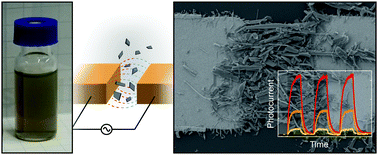Dielectrophoretic assembly of liquid-phase-exfoliated TiS3 nanoribbons for photodetecting applications†
Abstract
Liquid-phase exfoliation is a technique capable of producing large quantities of two-dimensional materials in suspension. Despite many efforts in the optimization of the exfoliation process itself, not much has been done towards the integration of liquid-phase-exfoliated materials in working solid-state devices. In this article, we use dielectrophoresis to direct the assembly of liquid-phase-exfoliated TiS3 nanoribbons between two gold electrodes to produce photodetectors working in the visible region. Through electrical and optical measurements we characterize the responsivity of the device and we find values as large as 3.8 mA W−1, which are more than one order of magnitude higher compared to state-of-the-art devices based on liquid-phase-exfoliated two-dimensional materials assembled by drop-casting or ink-jet methods.



 Please wait while we load your content...
Please wait while we load your content...